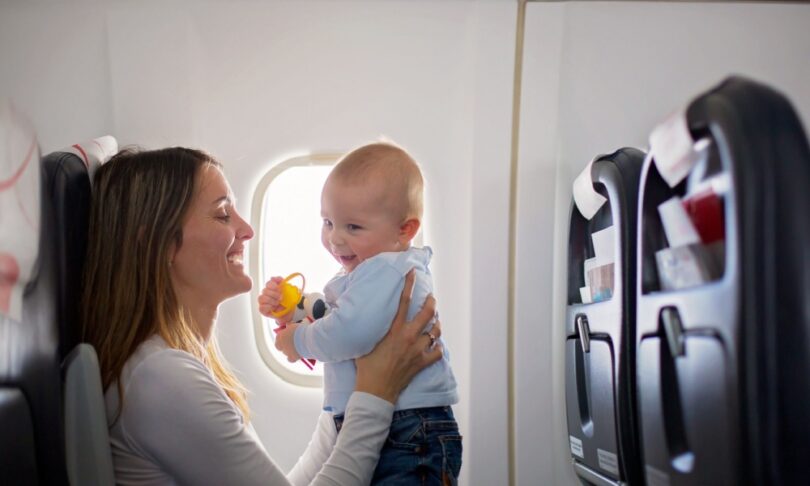Flying with a baby brings out all the emotions — excitement, nerves, maybe a little sleep-deprived confusion as you pack that third pacifier “just in case.” Whether you’re embarking on baby’s first trip to meet the grandparents or you’re already seasoned family travelers by now, there’s something special (and yes, occasionally chaotic) about boarding a plane with your tiniest co-pilot in tow.
For many generations of air travel, parents have held their babies in their arms while on the plane. But as family travel continues to evolve, more parents are starting to explore their options and ask important questions about what’s best for their child in the air — affordable, convenient, and above all, safe.
The question of the day: should babies be flying on their parents’ laps?
Why Lap-Sitting Has Been the Status Quo
If you’ve flown with a baby recently, you’ve probably heard the same thing from the airlines. Infants under the age of two can ride free (or very close to free) on your lap for domestic flights, and many international routes only charge taxes or a small percentage of the adult fare. It’s a budget-friendly policy that’s been standard for decades and feels like a rare win for families who are traveling.
Let’s be honest: Most parents choose lap seating because it’s more economical during a very expensive life phase — diapers, bottles, strollers, car seats, toys, toys, toys… But lap seating is also about convenience. Less gear. Simpler logistics. And it’s what most of us experienced ourselves when we were little, so it feels kind of normal, even cozy — almost like a rite of passage (albeit one that includes wrestling your infant while trying not to spill your ginger ale at 38,000 feet).
What the FAA and Other Authorities Say
 Right now, the Federal Aviation Administration (FAA) allows infants under two to ride on their caregiver’s lap. However — and this is a big one — they don’t recommend it due to safety concerns. We’ve all heard the stories about what happens to people when they aren’t wearing their seatbelts and the plan encounters significant turbulence. Now imagine what could happen to your baby in such a situation. The FAA strongly encourages parents to have their babies fly in a FAA-approved car seat or restraint system in their own paid seat. So even though you might not technically be breaking any rules by holding your baby while flying, you may want to see what other options are out there.
Right now, the Federal Aviation Administration (FAA) allows infants under two to ride on their caregiver’s lap. However — and this is a big one — they don’t recommend it due to safety concerns. We’ve all heard the stories about what happens to people when they aren’t wearing their seatbelts and the plan encounters significant turbulence. Now imagine what could happen to your baby in such a situation. The FAA strongly encourages parents to have their babies fly in a FAA-approved car seat or restraint system in their own paid seat. So even though you might not technically be breaking any rules by holding your baby while flying, you may want to see what other options are out there.
The National Transportation Safety Board (NTSB) has gone one step further. For years, they’ve been pushing for a rule requiring all passengers — including infants — to have their own seat and restraint. After all, we buckle our babies into car seats for even the shortest drive — so it’s worth thinking about how that mindset might carry over to the skies. There’s even been talk of legislative changes, though none have passed yet — at least not in the United States. Still, the movement is growing.
Alternatives to Lap Travel
 So, what can you do instead? One option — per the FAA’s guidance — is to book your baby their own airplane seat and use a government-approved car seat or restraint device. Many infant-size car seats double up as FAA-approved seats — just look for the sticker that says it meets “FAA requirements.” These seats install relatively easily in most airplane seats (especially window ones), and it can help keep your baby snug, safe, and perhaps more likely to sleep, too.
So, what can you do instead? One option — per the FAA’s guidance — is to book your baby their own airplane seat and use a government-approved car seat or restraint device. Many infant-size car seats double up as FAA-approved seats — just look for the sticker that says it meets “FAA requirements.” These seats install relatively easily in most airplane seats (especially window ones), and it can help keep your baby snug, safe, and perhaps more likely to sleep, too.
Not all families can spend the extra cash, especially on international flights, but even here there are alternatives worth exploring. Some airlines let you use devices like the CARES harness for older toddlers (at least one year old and over 22 pounds), and there are inflatable seat extenders for international business class bassinets (check with your airline first — they all have different rules). If nothing else, practice strapping your car seat in during pre-flight prep so you’re not fumbling while boarding with your stroller, diaper bag, and a squirmy baby in tow.
Related: Baby Steps! Everything You Need to Know About Flying with a Baby
What Parents Are Doing Now
 So what’s actually happening on the tarmac these days? According to recent surveys and anecdotal reports, more parents are shelling out for the extra seat. They’re doing their homework and buying the FAA-approved car seats. They’re asking airlines tough questions, using social media to share experiences, and reshaping the family travel space one flight at a time.
So what’s actually happening on the tarmac these days? According to recent surveys and anecdotal reports, more parents are shelling out for the extra seat. They’re doing their homework and buying the FAA-approved car seats. They’re asking airlines tough questions, using social media to share experiences, and reshaping the family travel space one flight at a time.
You’ll also see more travel gear hitting the market tailor-made for flying with babies — a true sign that the industry is catching on. Collapsible travel car seats, ultralight bases, compact boosters, and even foldable travel bassinets are gaining popularity. Parents like you are shopping smarter, traveling better, and leading the charge toward safer skies for our kiddos.
FAQs:
Q: Are there size limits for car seats on planes?
A: Yes. Your car seat must fit within the width of the airplane seat — typically around 16 to 17 inches. Rear-facing seats are bulkier, so always check your seat’s dimensions and call your airline ahead of time to confirm fit.
Q: Can I bring breast milk, formula, or baby food through airport security?
A: Absolutely. TSA allows reasonable quantities of breast milk, formula, and baby food, even if it exceeds the usual 3.4 oz. liquid limit. Just let the agent know you have baby items when you go through security.
Q: Where should I sit on the plane if I’m bringing a car seat?
A: The window seat is recommended. FAA rules typically require child car seats to be installed in window seats so they don’t block passengers in a row from exiting in an emergency. Aisle and middle seats usually won’t work.
Q: Does my child’s car seat need to be FAA-approved to use on a plane?
A: Yes. The car seat must have a label that reads: “This restraint is certified for use in motor vehicles and aircraft.” Booster seats are not approved for airplane use, as they require a lap-and-shoulder belt.
Q: Can I pre-board if I’m traveling with an infant?
A: Most airlines offer family pre-boarding for travelers with small children — even before Group 1. Take advantage of it to get settled, install your car seat, and breathe for two seconds before takeoff.
Have you ever booked an airplane seat for your baby? Tell us how it went in the comments section!









